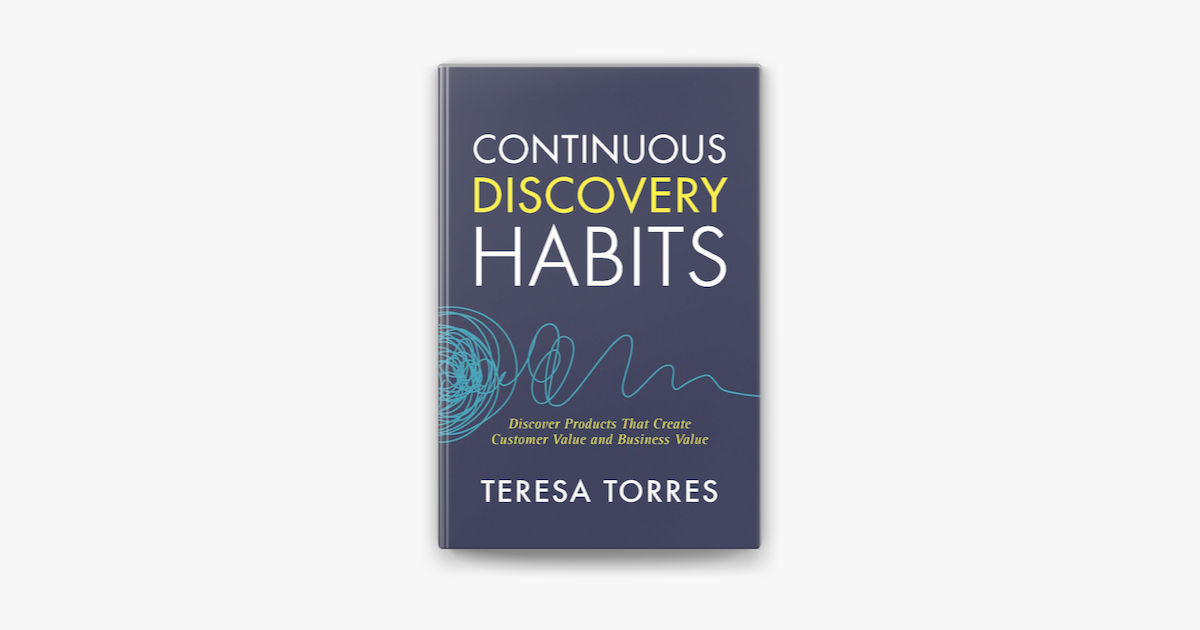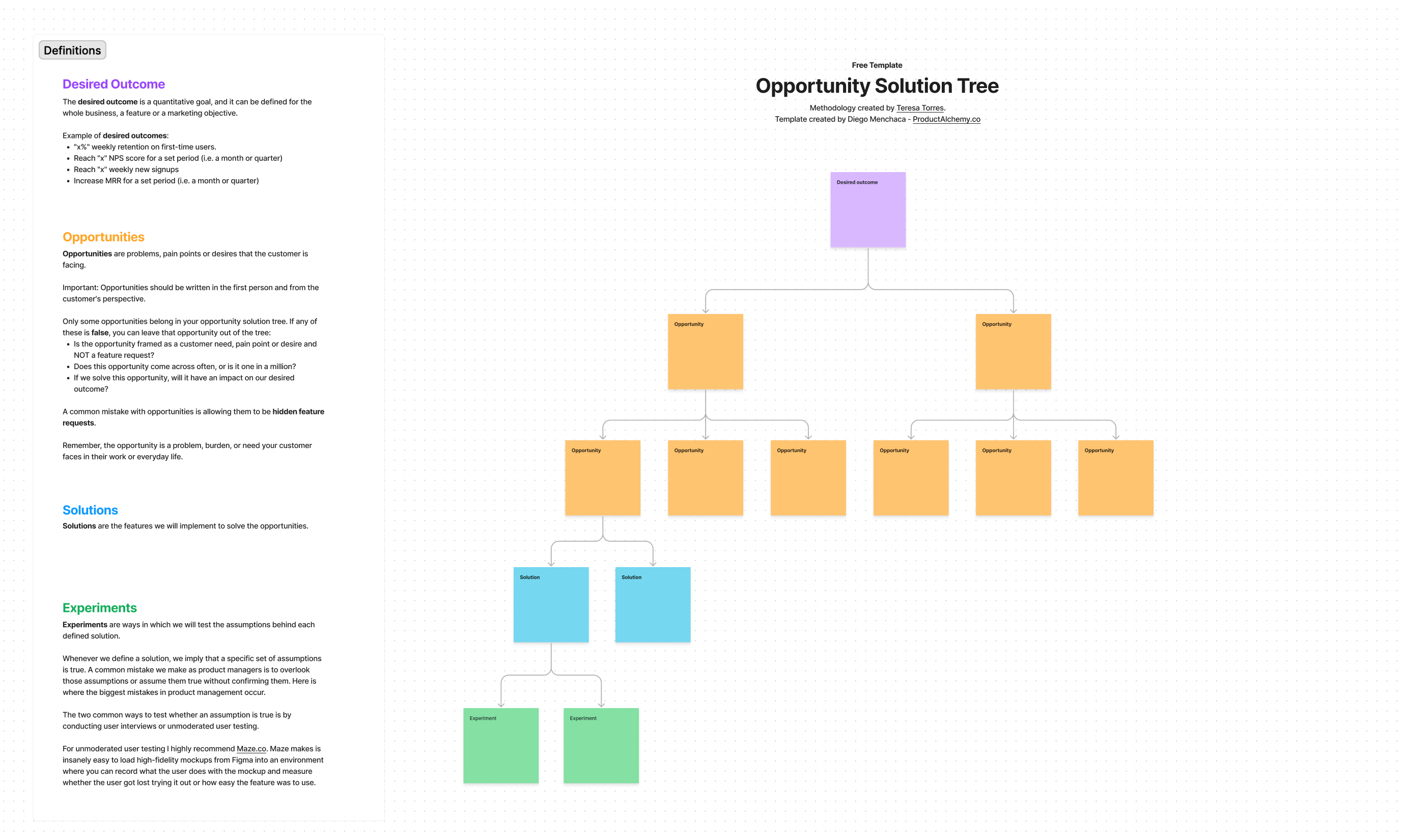Continuous Discovery Habits
In Continuous Discovery Habits, Teresa Torres provides a practical framework for integrating ongoing customer research into daily product decisions through 5 key habits. The book focuses on transforming discovery from a one-off event into an ingrained practice that fuels product-market fit.

Products built on assumptions crash. No matter how smart teams believe they are, guessing what users want leads to misfires.
The graveyard of failed tech is filled with apps no one needed, products no one wanted. To avoid joining the ranks of the irrelevant, companies must connect with real people and insights.

Continuous Discovery Habits presents the blueprint for this regular customer immersion. The book provides the mindsets and methods to sustain real-world learning, not intuitions. By transforming product development into a discovery-driven engine fueled by users, teams create innovations that deliver outcomes that matter. They build what customers value.
Continuous Discovery Habits by Teresa Torres provides a practical framework to help teams overcome this problem through regular customer research. The book outlines five simple but powerful habits to incorporate meaningful customer feedback and findings into product development on an ongoing basis.

Torres draws on her diverse experience leading product and design to illustrate why continuous discovery is critical for creating valuable products users love. She shares tangible steps any team can take to turn customer perspectives into insights that shape decisions and drive innovation.
While continuous discovery may sound complex, Torres focuses on incremental improvements centered on core principles. Her habits provide a flexible roadmap to embed customer-centricity into everything you build. By adopting these practices, teams can transform product development into a truly discovery-driven process fueled by real-world insights.
The book succeeds in teaching both the mindsets and tactical steps needed to sustain a culture of continuous discovery.
For any product team looking to consistently build the right things, Continuous Discovery Habits is an indispensable guide.
Key Takeaways
- The 5 core discovery habits (focusing on outcomes, visualizing knowledge, continuous interviewing, mapping opportunities, and prioritizing opportunities over solutions) provide a framework for integrating meaningful customer insights into product decisions on a regular basis.
- Supporting mindsets like being customer-centric, outcome-oriented, collaborative, visual, experimental, and continuous are essential for the habits to take hold and transform product development culture.
- The habits and mindsets create an actionable roadmap for making discovery a habitual, ongoing practice rather than a one-off event. This bridges the gap between customers and product teams.

Background
Teresa Torres is a Product Discovery Coach with diverse experiences in UI design, Product management, and Interaction design. She has around 18+ years of experience in the field. Before becoming a coach, Teresa spent the majority of her career leading product and design teams at early-stage internet companies.
Most recently, she was the VP of Products at AfterCollege, an Internet startup that helps college students find their first job. She was also the CEO of Affinity Circles, an online community provider for university alumni associations and a social recruiting service used by Fortune 500 companies. Additionally, she held product and design roles at Become.com and HighWire Press.
The book "Continuous Discovery Habits" was published in 2021 and focuses on helping product teams build better products by incorporating continuous discovery practices. The book provides a framework for developing a culture of discovery within product organizations, outlining a series of habits that can help teams stay in touch with customer needs and market trends.
What is Continuous Discovery?

Continuous discovery is an ongoing process of conducting small research activities with customers to inform product decisions on a frequent basis. The goal is to infuse daily product decisions with real-world customer input, rather than relying solely on assumptions. The goal is to create customer value by deeply understanding their needs. The result is compounding business value.
This aligns product development with actual customer needs and market trends. It enables teams to course-correct based on learnings from current users. The frequent small doses of discovery create long-term product-market fit and value.
The importance of continuous discovery is to bridge the gap between customers and product teams. It prevents teams from operating in a bubble and building features no one wants. By integrating discovery into daily decisions, product teams stay connected to the market and build for real user needs. This creates substantial competitive advantage over the long run.
The continuous discovery process is difficult to master, but powerful once the habit is built. The key is to build a structured and sustainable approach that you are able to continue over time. Customer interviews bring first-hand insight into the market.
Overall, continuous discovery is a critical process to iteratively align products with the market through ongoing customer research, dialogue, and feedback. It moves product development from guesses and speculation to facts and insights that fuel customer-centric products.
The Continuous Discovery Habits

The heart of Continuous Discovery Habits is the five key practices Tores outlines to integrate meaningful customer insights into product decisions. These core habits provide a structured yet flexible framework that teams can implement to make discovery a consistent part of their process. Rather than changing behaviors overnight, Tores focused on incremental improvements centered on certain principles.
By adopting these habits, teams can transform product development into a truly customer-centric process fueled by real-world insights. The five habits provide a roadmap to build a discovery-driven organization and avoid operating from assumptions.
- Focusing on Outcomes Over Outputs
Prioritize delivering customer and business outcomes rather than just outputting features. Evaluate if features actually generate desired outcomes. Maintain an outcome-driven mindset. - Visualizing What You Know
Use visual artifacts like journey maps, Venn diagrams, and graphs to communicate insights from discovery. Visualize relationships between customers, insights, and opportunities. - Continuous Interviewing
Conduct regular short customer interviews to gather insights. Seek to validate assumptions. Uncover pain points and observe behaviors. Let findings inform decisions. - Mapping the Opportunity Space
Identify, organize and prioritize pain points, needs, and opportunities uncovered through discovery. Map relationships between opportunities and target customers. - Prioritizing Opportunities, Not Solutions
Avoid jumping to solutions. Prioritize addressing customer problems and opportunities. Let solutions emerge from insights rather than preconceived notions.
These core habits transform product development into a discovery-driven, customer-centric process that fuels innovation.

Mindsets for Successful Adoption
- Outcome-oriented - Focus on delivering customer and business results, not just features. Tie efforts to tangible outcomes.
- Customer-centric - Keep the customer perspective at the center of all decisions. Build empathy through regular engagement.
- Collaborative - Discovery is a team effort requiring collaboration across functions. Break down silos.
- Visual - Use visualizations to capture insights and build shared understanding. Pictures communicate discoveries.
- Experimental - Discovery is based on running small experiments and learning from results. Test assumptions.
- Continuous - Weave discovery into the cadence of regular work rather than isolated efforts. Make it ongoing.
Cultivating these mindsets across teams establishes an environment where discovery habits can thrive. It is key for product managers to build strong relationships with business stakeholders, sharing insight into customer needs and clear outcomes from the discovery before they move into customer delivery.
They enable practices to take hold through context, not just actions. With supporting mindsets, discovery habits transform culture.
Critical Assessment

One of the strengths of Continuous Discovery Habits is how Tores utilizes compelling stories and research to illustrate her advice. The habits she overhauled in her own life make the concepts relatable. Tores also incorporates client stories from her coaching practice showing real-world application. Along with the anecdotes, Tores leverages scientific studies on habit formation providing credibility.
The habit discovery framework lays out clear components that readers can easily apply. Tores provides templates for designing experiments, tracking your observations, and reflecting on results. These habit discovery sprints offer actionable steps while still encouraging customization based on your needs.
For those accustomed to rigid habit tracking and preset goals, Tores' flexible approach may require discipline. She offers less structure in favor of open-ended personal discovery, which some readers may struggle with. However, her encouragement to start small and focus on consistency can overcome the need for excessive structure.
While Tores shares some examples of long-term habit change, the book could benefit from more examples spanning months rather than weeks. This would showcase the power of small consistent actions compounded over years. Though Tores conveys the concept well, extended real-world examples would enhance the ideas.
Overall, the book's emphasis on self-discovery over perfection provides a refreshing and sustainable take on habit change. Tores succeeds in teaching the mindsets and principles to drive lasting transformation.
Recommendations

I recommend using Continuous Discovery Habits as a guidebook at each stage of your product development process. The chapters align with key phases like framing opportunities, researching users, designing solutions, and measuring outcomes.
Read the chapters that map to your current stage in the product lifecycle to maximize the benefits. For example, absorb the insights on framing opportunities and customer research when scoping new ideas. Then revisit the sections on experiment design and outcome measurement when validating concepts.
The book provides value to any product manager, designer, engineering leader or product executive looking to integrate discovery into their work. The habits apply across roles and functions.
Teams should read Continuous Discovery Habits together and discuss how to implement the mindsets and practices in their context. The habits will stick best when adopted collectively.
Use the book as your handbook to transform product development into a truly discovery-driven process. Let Tores' wisdom guide your team at each stage, cementing customer-centricity into everything you build.
Criticisms

With just over 200 pages, Continuous Discovery Habits is a relatively short read that does not aim to be a comprehensive guide on qualitative research and data analysis. Tores provides a high-level framework focusing on mindsets and principles more than detailed methods. This leaves some aspects of discovery underdeveloped.
For example, the book explores one interviewing technique and opportunity mapping method. But discovery pros may desire more info on additional qualitative approaches, sampling strategies, analysis tactics etc. The brevity limits the book's utility for experienced researchers.
Additionally, Tores put forth one methodology recommendation for each step of the process. However, different product teams may benefit from alternative methods based on their context. Providing multiple options for various situations could improve the book's applicability.
While the concise nature makes Continuous Discovery Habits an accessible introduction, more depth on research methods and additional options to choose from would make the book more comprehensive and applicable. It covers discovery principles well but leaves some execution details to be desired.
Conclusion
Continuous Discovery Habits by Teresa Torres is a practical guide for product teams aiming to make customer research a daily habit that drives decisions. The book provides a valuable, actionable framework for developing a discovery-focused culture within product organizations.
Torres outlines five core discovery habits - like continuous interviewing and prioritizing opportunities over solutions - that help teams stay closely connected to customer needs and market trends. The habits and supporting mindsets create a toolkit for sustaining customer-centricity.
While the book may not serve as a comprehensive manual on qualitative research and data analysis, its brevity makes the framework accessible. Torres focuses on discovery principles rather than detailed tactics. For product teams looking to form ongoing discovery rhythms, Continuous Discovery Habits offers the right blend of concrete steps and adaptable guidelines to inform daily product decisions.
The key is transforming discovery from a one-off event into a habitual practice integrated with the product development lifecycle. Torres' book enables this shift through practical advice that builds team abilities, rather than just prescribing research methods.
For organizations aiming to sustain continuous learning about their customers, Continuous Discovery Habits is a valuable resource.

